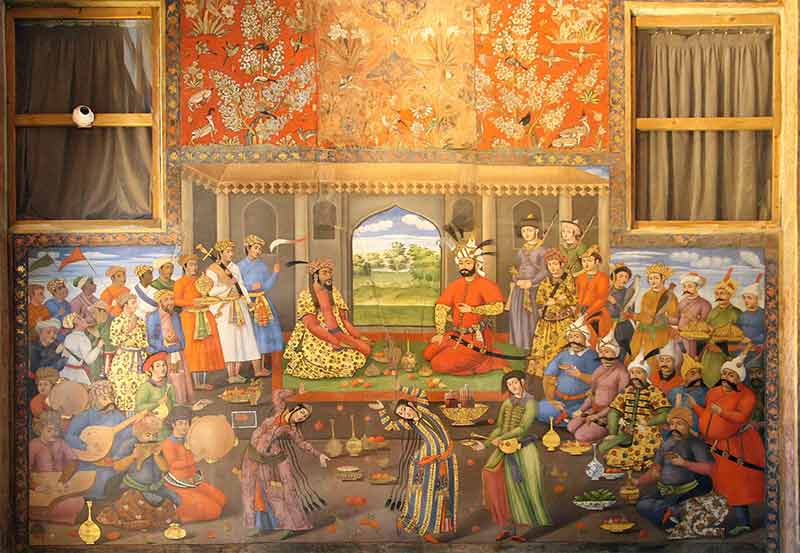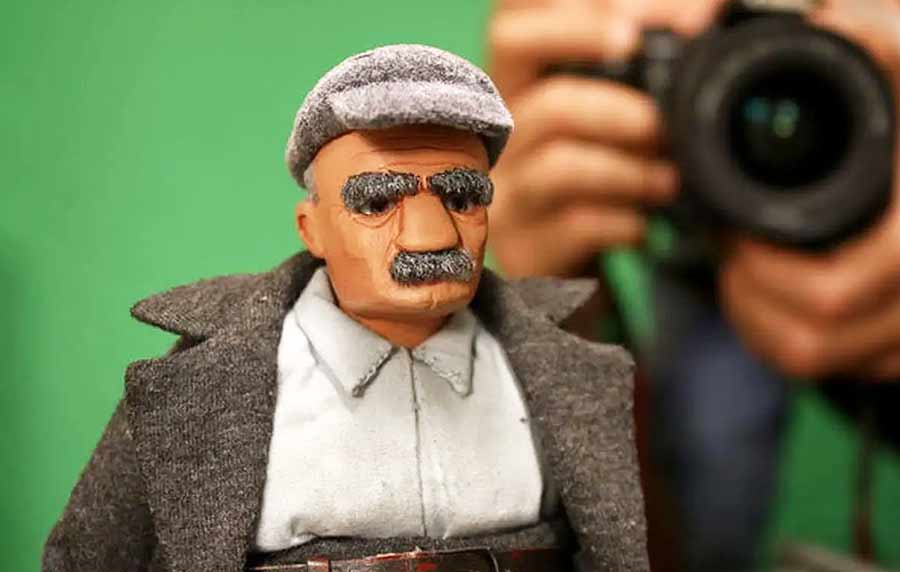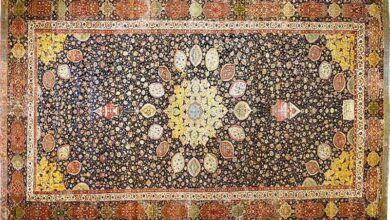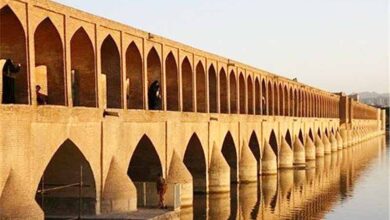Painting in Safavid Era

Safavid era is one of the brightest periods of Islamic art in Iran. The painting achievements of Herat and Kamaluddin Behzad schools reached their peak in this period and then with the advent of Isfahan school, the art of painting was permanently released from the shackles of writing and became independent.
When Shah Abbas I came to power in 996 AH, the miniature of Iran, which had a brilliant background from the Timurid and early Safavid eras. It flourished, and the talented and talented painters continued to seek guidance in diversifying their work and inventing new and evolving techniques. This endeavor began with the “Herat School”, which is one of the most important and original miniature schools in Iran, and found another color in Tabriz during the reign of Ismail Safavid (905-930 AH). Its consistency can be seen in the brilliant school of Tabriz, which was formed by the efforts of Kamaluddin Behzad’s students such as Agha Mirk and Sultan Mohammad.
The heyday of art in the Safavid era in the palaces of cities such as Isfahan, Qazvin and Tabriz, which were considered the center at that time, has adventures that have been recorded in history.
This school, which may be the culmination of Iranian painting in terms of detail and decoration, is also the latest shine of the workshop tradition and writing of Iranian painting.
Perhaps the most brilliant achievement of this school is the beautiful Shahnameh of Tahmasebi, which took almost 28 years to write. This brilliant work has 258 images in a large ministerial cut. The painting of the court of Kiomars, the work of Sultan Mohammad, in this version took about 3 years to complete! This valuable work was presented as a gift to the court of the Ottoman Sultan Salim II.
But the period of decline and dispersion of art and deprivation and the door of artists under the protection of the royal houses of that time, after the decline of the Safavid era, has a more interesting story that eventually led to the release of art from the shackles of the court and its expansion into society. After the fall of the Safavid rule and the establishment of the Afshari dynasty and Nader’s death and the creation of chaos in the country and the subsequent coming to power of Karim Khan Zand, and the rule of Agham Mohammad Khan and the establishment of the Qajar dynasty after the decline of the Zandi era; Iranian painting also undergoes changes and developments in the type of look, materials and materials, social approaches as well as the way of presentation and technique.
The attention and importance that the Safavid kings paid to art and the artist was not given to artists by Karim Khan Zand. As a result, the artists who had lost the support of the court and the economic prosperity of the Safavid period, were forced to turn to the lower classes and some aristocrats with culture, and especially to the middle classes of society.
This new approach in art was due to the presence of new audiences that artists have to adapt to their level of taste and mood.
During the reign of Shah Tahmaseb (930-984 AH) with the transfer of the capital from Tabriz to Qazvin and the beautiful conquests that took place in the former school, the “Qazvin school” emerged, which had many magics of the “Herat” and “Tabriz” style. . In addition, it benefited from other subtleties such as the rejuvenation and beautification of the faces of the people and the details in the landscapes of the royal palaces. It is true that audiences from the urban middle classes had lower aesthetic expectations than courtiers, but this difference in level only led to the removal of some of the arrays and ornaments. Therefore, he replaced the visual element and popular taste with the popular element and popular taste.
After the decision of Shah Abbas, the capital of Iran was moved from Qazvin to Isfahan, some painters of the Safavid court also moved to Isfahan and in this artistic city, they tried to create their valuable paintings in miniature. New tastes that these powerful painters such as Reza Abbasi, Habibaullah Mashhadi, Fazluddin Hosseini, Sadeghi Beyk, Moin Musour and Mohammad Yousef emerged in creating original works by protecting the originality of art, and changes in the scenery, painting, attention and face. They created single-faceted and multi-faceted paintings, exposed a new style that was different from the previous schools and became known as the “Isfahan School”.
The infant school was mentioned, which progressed step by step until the middle of the Shah Safi era, and master masters such as Shafi Abbasi, Mohammad Yousef, Sadeghi Beyk, and Moin Musour illustrated and prospered it. It went so far that if it did not reach the base of Herat and Tabriz schools in some aspects, including painting, but in the form of assemblies and single-person figures, it prevailed over the previous schools. One of the features of this style in portraiture is its approach to simulation, which is noteworthy and pleasant in parliament. In this school, the miniature of Iran significantly increased the influence of Chineseization, and the faces and landscapes became closer to reality, and the colors became soft and opaque.
Among the nominees of this time is Reza Abbasi, who, while new in his work, observed the originality of style and, in addition to parliamentarism, was the only era in single formulation, perfecting the style of Sheikh Mohammad Sabzevari and the contemporary painter Shah Tahmaseb.
The Isfahan doctrine, after a period of growth and development, became more and more degenerate as it approached the final Safavid era, and this decline was evident not only in this school but also in other schools. In general, Iranian miniatures tend to fall at their peak Found.
Because after more than two hundred years that have passed since the beginning of the development of miniatures and valuable masterpieces in Iranian painting by great masters such as Junaid, Behzad, Mirk, Sheikhzadeh, Mohammadi, Sultan Mohammad, Mirsaid Ali and Mirza Ali and others came to the field of intuition. The cause of the stagnation and degeneration of this art was the emergence of a change in the style of painting, and the emergence of a new style that, while different from miniatures, was favored by artists. Therefore, some masters, after getting acquainted with the method followed by Indian painters in adapting some of the features of Farangistan painting and getting acquainted with this style from Western smiles, decided to make logical changes in Iranian painting. Create a new style and this tendency is the beginning of the influence of Iranian painting on Western schools.
From this new tendency, which was in harmony with the collective psyche of the masses and introduced an unprecedented kind of vulgarity to Iranian painting, something was obtained that had been imprisoned for centuries behind the walls of the royal palaces and in the hearts of ordinary people. That was the burning love of the people for the national epics in the form of poetry, as well as their faith in the passion of Ashura philosophy.
Now, the pulse of transformation is clearly beating in the hearts of cities. Some artists, along with the people, listened to the narrators and preferred the coffee house to the royal palace. In the process of passing from painting in the Safavid era to the Qajar period, there were gradual changes in the techniques, tools and type of look in Iranian painting.
Signs of these changes can be traced to the spread of iconography, which nurtured in its heart a storytelling and narrative art called “coffee house painting.” The important point is to remember that from Safavid onwards, European painting is slowly entering the Iranian society and the Iranian artist, without turning a blind eye to accepting and imitating the “isms” of Western art; He just used new tools like paint, oil and canvas.
But what he created with these imported items was full of national and religious culture, of faith, feeling and imagination, literature and history. According to the history of art, paint, oil and canvas were not used among our painters before Safavid times.
The dynasties of the monarchy had done with the national pride and faith of the people that when the stage was set for the eruption of suffocating hatreds in their chests, a current emerged in the context of Iranian culture that could not be found in any other culture. The hatred of history explodes with the tired voice of the narrators, and the hands of the painters, instead of glittering ornaments, play the role of the oppressors and Ashqia. And he portrayed the pure times with luminous faces and the spirit of justice in the center of the curtain. “Muqatil Khani”, which is the cry of the Shiites who believe in the oppression of the Yazidis, was sung from the larynx of narrators and curtain singers in every dormitory and barzani. Painters also depicted this style and faithful litigation.
Afshar, Zand and Qajar came and went… But in the depths of the culture of these people, a counter-reading and narration and painting of a coffee house emerged.
The official painters who have always been at the threshold of the Dar al-Saltanahs for centuries, gradually in the great wave of people with faith and simplicity who, behind the walls of the Dar al-Saltanah, share their stories, sorrows, sufferings, aspirations and aspirations. And with vigor they kept disappearing.
People who rediscovered their true painters in the warmth and intimacy of the café created something in the alleys and back alleys of cities that never, even up to this point, deserved it. Not advertised. In nineteenth-century Europe, in Paris, the Moulin Rouge, a hangout for Parisian dancers and painters, has entered the written history of art. And all art students all over the world are familiar with this name and the issues surrounding it.
When you do not know your fellow artist painter, the acquaintance with the French painter Lautrec and the hangout of Moulin Rouge becomes a leaf of art memories. It is very important to get acquainted with a talented painter like Lutherk, but the pain is that no one knows Hussein Qollar Aghasi.
This is how a problem called “unconsidered modernity” arises. A dilemma that has subsequent consequences such as “fanatical traditionalism” and “careless beardlessness and facelessness.”
The farther we get from Safavid and closer to Qajar, the more the process of getting acquainted with European art takes on dimensions. This acquaintance is more like a meeting, a meeting whose first results lead to a kind of “combination” and not “imitation”.
A combination that is difficult to break due to the lack of a critical element and a preserving factor, such as scientific historiography and the analysis of cultural factors, and each of which may slip into the abyss of imitation.
It is carefully in this period that two major approaches to painting (nineteenth century AD) in Iran can be clearly seen. The first approach, which has its roots in the depths of society and is known as a coffee house painting, is decorated with the name of Hossein Qollar Aghasi. And the second approach, which is close to the official centers and higher levels of society, and creates the same stream at the head of which the name Kamalolmolk shines.
Tenth century painting in the shadow of the Safavid rule
Bukhara painting had a citylike appearance, not a royal and courtly style. Confirmed. And this was the version that was provided to Shah Tahmasb, the second king of the Safavid dynasty, between 945 and 949 in Tabriz.
* Sources and references are available in the editorial office of Artmag.











